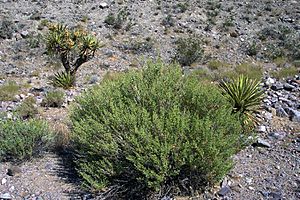Desert brickellbush facts for kids
Quick facts for kids Brickellia desertorum |
|
|---|---|
 |
|
| Scientific classification | |
| Kingdom: | |
| (unranked): | |
| (unranked): | |
| (unranked): | |
| Order: | |
| Family: | |
| Subfamily: |
Asteroideae
|
| Tribe: |
Eupatorieae
|
| Genus: |
Brickellia
|
| Species: |
B. desertorum
|
| Binomial name | |
| Brickellia desertorum Coville
|
|
| Synonyms | |
|
|
Brickellia desertorum is a type of flowering plant known by its common names: desert brickellbush and desert brickellia. It belongs to the daisy family, which includes many familiar flowers. This plant grows naturally in Mexico, Central America, the West Indies, and the southwestern United States. You can find it in the Mojave and Sonoran Deserts, especially in California, Nevada, and Arizona.
Discovering the Desert Brickellbush
The desert brickellbush is a fascinating plant that thrives in dry, desert environments. It's well-adapted to its surroundings, making it a unique part of the desert ecosystem.
What Does This Plant Look Like?
Brickellia desertorum is a bushy shrub that can grow up to about 1.5 meters (5 feet) tall. Its stems have many branches and are covered in tiny hairs.
- Leaves: The leaves are small, oval-shaped, and have slightly toothed edges. They are usually less than 1.2 centimeters (half an inch) long.
- Flowers: The plant's inflorescences (flower clusters) grow at the ends of its branches. Each cluster contains several flower heads. These heads are about one centimeter long. They are covered by greenish, purplish, or yellowish phyllaries, which are like small, protective leaves. Inside each head, there are 8 to 12 tiny, tube-shaped disc florets.
How Does It Reproduce?
After the flowers bloom, the plant produces fruit. The fruit of the desert brickellbush is a hairy, cylinder-shaped achene. It is very small, only about 2 or 3 millimeters long. Each achene has a pappus at its tip, which is a tuft of bristles. These bristles help the seeds to be carried by the wind, allowing the plant to spread to new areas.

